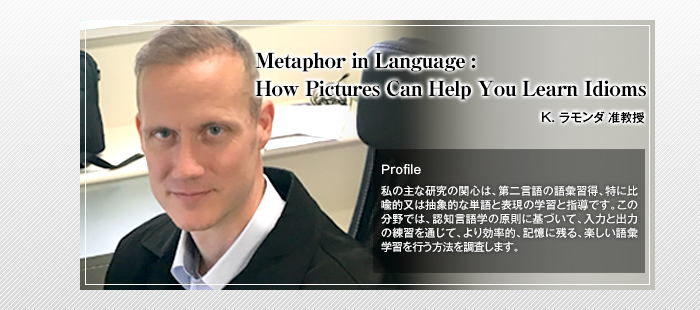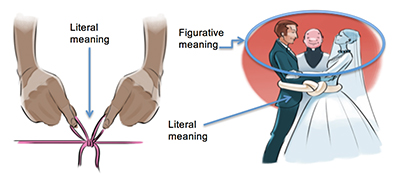- トップ
- 教員が語る専門領域の魅力
- 教員が語る専門領域の魅力 vol.15 K. ラモンダ 准教授
K. ラモンダ 准教授

What role do pictures play in language learning?

There has been a lot of research on the effect that pictures have on learning new words. Take, for example, a case where you meet a new word, and there is a picture of the word intended to help you understand its meaning. Does looking at and understanding this picture help you or hinder you from learning the word? The answer is it depends. For learning the word form (such as spelling), pictures can be a distraction, because your attention is divided between looking at the picture and the word form. On the other hand, pictures can be very useful to remember the word’s meaning in the long-term. Research has found that the brain uses both verbal and visual pathways to store information. As a result, when you use both pathways to store a new word’s meaning, you have stronger access to it when you try to later recall it. But what kinds of words are the best to pair with pictures to help learners?
What are idioms and why are they important?
An idiom is a group of words that together have a figurative (metaphorical) meaning. Some examples of idioms in Japanese include 出る杭は打たれる、石の上にも三年、八方美人、高嶺の花 and so on. The metaphors in idioms often come from history and culture, and as a result they can be difficult to understand and learn. Yet they are important because native speakers use them often, especially in certain kinds of social situations. Furthermore, skillful use of idioms can help non-native speakers integrate into local communities overseas, because their use can show an appreciation and understanding of the local culture. Wordplay involving idioms is also very common, and the creative use of language in this way can be endearing to listeners in casual conversation. However, as idioms’ meanings aren’t very clear from a reading of their literal words, they present a special challenge to second language learners.
How pictures can strengthen your memory of idioms.

Pictures can help learners understand and remember the meaning of idioms better by showing the metaphorical meaning through the literal meaning. By combining the two types of meaning (literal and metaphorical) in a picture, the learner can create a visual pathway in the brain to an image that packages both meanings together. Consider the two pictures on the left for the idiom “tie the knot”, which means “to get married”. The left picture only shows the literal words (a knot being tied), whereas the right picture shows the metaphorical meaning, through a wedding ceremony (metaphorical meaning) and a knot tied (literal meaning) around the couple. By bundling both meanings together visually, learners stand a better chance at accessing the metaphorical meaning as well as the literal meaning. In this way, pictures can help learners more efficiently remember the metaphorical meaning of idioms.
学生のみなさんへのメッセージ
Will Rogers once correctly said that “everyone is ignorant, only on different subjects”. Any one person only knows a small amount of the total sum of knowledge in the world. For this reason, it’s important not to overestimate what you know and always assume that you can learn something new from the person you are listening to.






